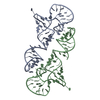+Search query
-Structure paper
| Title | Structure of a conserved retroviral RNA packaging element by NMR spectroscopy and cryo-electron tomography. |
|---|---|
| Journal, issue, pages | J Mol Biol, Vol. 404, Issue 5, Page 751-772, Year 2010 |
| Publish date | Dec 17, 2010 |
 Authors Authors | Yasuyuki Miyazaki / Rossitza N Irobalieva / Blanton S Tolbert / Adjoa Smalls-Mantey / Kilali Iyalla / Kelsey Loeliger / Victoria D'Souza / Htet Khant / Michael F Schmid / Eric L Garcia / Alice Telesnitsky / Wah Chiu / Michael F Summers /  |
| PubMed Abstract | The 5'-untranslated regions of all gammaretroviruses contain a conserved "double-hairpin motif" (Ψ(CD)) that is required for genome packaging. Both hairpins (SL-C and SL-D) contain GACG tetraloops ...The 5'-untranslated regions of all gammaretroviruses contain a conserved "double-hairpin motif" (Ψ(CD)) that is required for genome packaging. Both hairpins (SL-C and SL-D) contain GACG tetraloops that, in isolated RNAs, are capable of forming "kissing" interactions stabilized by two intermolecular G-C base pairs. We have determined the three-dimensional structure of the double hairpin from the Moloney murine leukemia virus ([Ψ(CD)](2), 132 nt, 42.8 kDa) using a (2)H-edited NMR-spectroscopy-based approach. This approach enabled the detection of (1)H-(1)H dipolar interactions that were not observed in previous studies of isolated SL-C and SL-D hairpin RNAs using traditional (1)H-(1)H correlated and (1)H-(13)C-edited NMR methods. The hairpins participate in intermolecular cross-kissing interactions (SL-C to SL-D' and SLC' to SL-D) and stack in an end-to-end manner (SL-C to SL-D and SL-C' to SL-D') that gives rise to an elongated overall shape (ca 95 Å×45 Å×25 Å). The global structure was confirmed by cryo-electron tomography (cryo-ET), making [Ψ(CD)](2) simultaneously the smallest RNA to be structurally characterized to date by cryo-ET and among the largest to be determined by NMR. Our findings suggest that, in addition to promoting dimerization, [Ψ(CD)](2) functions as a scaffold that helps initiate virus assembly by exposing a cluster of conserved UCUG elements for binding to the cognate nucleocapsid domains of assembling viral Gag proteins. |
 External links External links |  J Mol Biol / J Mol Biol /  PubMed:20933521 / PubMed:20933521 /  PubMed Central PubMed Central |
| Methods | EM (subtomogram averaging) / NMR (solution) |
| Structure data |  EMDB-1806:  PDB-2l1f: |
| Source |
|
 Keywords Keywords | RNA / retrovirus / packaging / cryo-ET |
 Movie
Movie Controller
Controller Structure viewers
Structure viewers About Yorodumi Papers
About Yorodumi Papers



 moloney murine leukemia virus
moloney murine leukemia virus